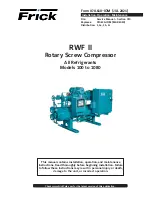
Operating manual - SAB 120-151 A-frame (including ATEX)
42/61
008668 en 2019.08
6.20
Heating element
To keep the compressor lubricating oil warm during a period of standstill, a heating element is
built into the oil reservoir. Before start-up, the heating element must be switched on for 6-8 hours
to ensure that only a minimum of refrigerant remains in the oil. If there is too much refrigerant in
the oil, the oil loses its lubricating properties.
Warning!
The heating element must not be switched on if the oil level in the reservoir is below minimum in
the sight glass. Normally, it must be turned off when the compressor is in operation.
Remember to turn off the heating element before draining the oil through the compressor service
valve and before opening into the oil reservoir for inspection.
ATEX:
On ATEX-executions, the heating element(s) are ATEX-approved. Heating elements from Johnson
Controls Denmark have a thermostat with manual reset. If the thermostat drops out, only compe-
tent personnel should reactivate it.
6.21
Start-up
Preparations before start-up
1.
Turn on the power voltage and the control voltage. Check the emergency stop button.
2.
Check the oil level in the oil separator, see subsection
3.
Check that all valves are positioned in accordance with
6.4: Valve positions during opera-
including the secondary side of the oil cooler.
4.
Reset all alarms according to the control system instructions.
5.
Check on the control display that the compressor capacity control system is in minimum
slide pos. 0-4%.
Warning!
On ATEX-executions, the limits in
must always be respected.
Temp. class
Max. surface
temp.
Max. temperature of oil to
shaft seal
Min. ignition temperature
of oil
T1
450°C
380°C
500°C
T2
300°C
230°C
350°C
T3
200°C
130°C
250°C
T4
135°C
65°C
185°C
T5
100°C
30°C
150°C
T6
85°C
15°C
135°C
Table 7: Temperature classes - screw compressors
6.22
Initial start-up procedure
Having performed the check points on the
installation
and
preparations before start checklist
, the
compressor unit is ready for start-up. It is important that an adequate refrigerant load is available
to load test the unit at normal operating conditions. The following points should be kept in mind
during initial start-up:
















































